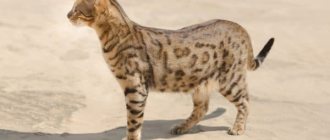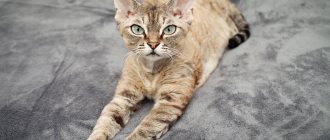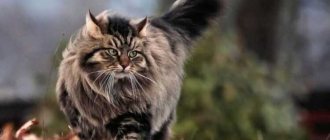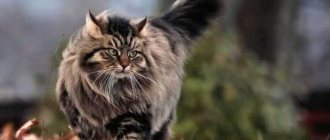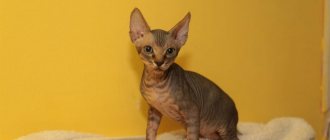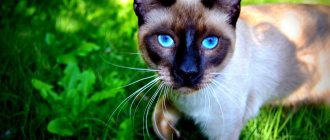The Siamese cat is a popular short-haired breed with a recognizable point color. Unique beauty is combined with sociability and intelligence. A good companion for those who value open expression of feelings and constant connection with their pet. These talkative cats will not let you get bored and will participate in all family activities.
| Breed | Siamese cat |
| Type | Siamese-oriental (eastern) group |
| Country of origin | Thailand |
| Coat | Shorthair |
| Lifespan | 15 – 25 years |
| Kitten price | 8000 – 35000 rubles |
History of the origin of the Siamese breed
The Siamese cat is one of the oldest and most famous cat breeds. Despite this, the origin of Siamese cats is still considered a mystery.
- The manuscript "Book Poems about Cats", dating back to 1350 - 1700, discovered in ancient Siam (modern Thailand), describes a pale cat with a dark coloration of the face, paws, ears and tail.
- According to legend, the Siamese were considered sacred. When a member of the royal family died, his soul was possessed by a Siamese cat, which then lived in the temple in luxury with monks and priests as servants. The theft and killing of a Siamese cat was punishable by death.
- Uncontrolled crossbreeding of Siamese in the 19th and 20th centuries led to cats no longer meeting the breed standard. Modern Siamese have become thinner and have acquired a characteristic triangular muzzle.
Subsequently, Siamese cats quickly became popular in different countries. This breed was first seen in Europe in 1871 at the London Cat Show. In 1879, a Siamese cat was given to the wife of the US President. The Siamese Cat Club was formed in 1901 in Great Britain, and the Cat Fanciers' Association (CFA) recognized the breed in 1906.
Related breeds:
- Oriental cat.
- The Balinese cat is a semi-longhaired Siamese cat.
- Burmanskaya.
- Thai is a restored Siamese breed according to the old type standard.
- The Himalayan is a long-haired breed developed by crossing Siamese and Persians.
Differences between Siamese and Thai breeds
Tags
Photo of the Siamese Fold is a Siamese FoldFeatures of the Siamese breedDescription of the Siamese catSiamese breed this breed appearedScottish breed comes in different breeds.Siamese breed Scottish breed.other cat breeds.Siamese Fold breedFlow-eared cat breedlife of a cat Fold cat Fold cat.Siamese cat Siamese cat appeared fold-eared cat. mutations of cats Siamese cats more Fold-eared cats refer to pull a cat in types of cats. breed of cats also species of cats completely breeds of cats
photo of a Scottish kitten answer to me non-products
Description of the Siamese breed
Let's look at the appearance and character of Siamese according to the breed standard.
Standard
Siamese cats are well balanced, boasting an athletic, flexible body and elegant, slender legs.
The breed standard for the modern Siamese cat assumes:
- Body: Elongated, tubular and muscular. A typical Siamese cat has a total height of 20-25 cm and a body length of 29-36 cm, with a body weight of 4-5 kg.
- Head: Straight profile with a strong chin and a pleasant, even bite. The head forms a perfect triangle from the tip of the nose to each tip of the ear. The neck is long. The eyes are almond-shaped, bright blue, and the ears are large, wide, located closer to the head.
- Limbs: The cat's hind legs are longer than her front legs, which adds to her athletic and graceful appearance. The paws are oval shaped and small. Thin tail.
- Coat: Short, shiny, fine coat without undercoat that lies close to the body.
Today, there are over 20 varieties of Siamese cat colors all over the world, and the most famous of them are:
- Seal point (brown or cream), with a cream-colored body and dark brown pigments on the nose and paws. It is believed that this was the original color of the breed when it was first exported from Siam (Thailand).
- Blue Point (blue) - the body is snow-white with a bluish tint, as well as a gray nose and paws.
- The Red Point is a white body with red (apricot) pigments on the nose and paws.
- The Caramel Point (light cream) is considered a hybrid due to a complex breeding process, with very light and pink pigments on the nose and paws.
- Chocolate point (black). The body is cream or milky in color, and the pigments on the points can range from chocolate to black.
- Cinnamon point (ivory). The body is ivory-colored, like a Chocolate Point, but the markings on the nose and paws are pinkish-brown.
Photos of colors
Seal Point
Blue Point
Red tabby point
Caramel point
Chocolate Point
Cinnamon Point
Appearance
The ears of such pets are widely spaced and quite large in size. With its elegant, aristocratic appearance, the Seychelles cat resembles a fragile figurine. But this perception is deceptive - she is resilient and strong. Her graceful, soft gait, full of dignity, reveals her as a native Englishwoman. And she is no stranger to royalty and willfulness. The heavenly gaze seems to penetrate into the depths of the soul and see right through. The exterior has characteristic features:
- The Seychelles cat has an average size and weight of 2-5 kg;
- The shorthair coat is longer on the belly, tail and shoulder girdle, and has no undercoat;
- Thin bone, well-developed muscles with a narrow chest;
- Slender, long limbs with neat paws - “pads”;
- Wedge-shaped elongated head with a narrow chin;
- The curve of the muzzle from the forehead to the nose is flattened;
- The ears are the “calling card” of the breed - large, widely spaced, with rounded corners;
- Almond-shaped eyes of any shade of blue, slightly slanted;
- A flexible, long tail that expresses the pet's emotions.
The color is pleasing to the eye
Such pets may have colored spots against the background of white fur. Color delights require special attention. According to the standard, the Seychelles coat should have a snow-white appearance with a point. The two-color “van” pattern is characterized by a white background with spots of a different color (black, red, gray). The tail is always multi-colored, often tortoiseshell. Based on the size and location of the spots, three types of color are distinguished. The Seychelles cat is distinguished by a mandatory feature - colored ears, paws, tail and mask. The mask does not take up the entire head.
Wayward character
Despite the rarity of the breed, people have already heard about the Seychelles. On the one hand, it is an intelligent, cheerful, active animal, on the other hand, it is a rebellious, stubborn creature.
The cat will try to subjugate other pets at home to its will and will not tolerate a fight for the owner’s attention. And she really needs it
These four-legged animals are obliged to enjoy universal favor and feel cared for and warm. Ignoring will lead to depression and illness. Selfishness forces the Seychelles to choose one of the family members as a favorite and bestow devotion only on him. However, cats get along well with children. All their lives (about 15 years) they are funny, playful and energetic. If someone dares to offend the “blue blood”, the animal will find a way to “revenge”.
A pet requires attention as a full-fledged member of the family. Over time, Seychelles dogs become pets and full members of the family, responding with friendliness, joy and affection to their owners for many years
Becoming the center of general pleasure, they bring a unifying principle into the house and develop discipline and responsibility. Talkativeness will prevent you from getting bored and sad.
Character of Siamese
Siamese are known for being one of the most intelligent and vocal cats in the world and will happily spend time with their owners. Siamese cats are affectionate with domestic cats, however, they can be demanding and suspicious of strangers. Many people say that their Siamese pets greet strangers at the door and go through some kind of approval process before visitors enter the house.
At the same time, Siamese cats are very active and love active games with toys. When it comes to training, they do not have any special exercise needs because Siamese cats are very active and playful in their own right.
They quickly get accustomed to the litter box and scratching post; the main thing is not to shout or force the cat to do anything. Siamese are quite proud and can become stubborn from such treatment. You can even toilet train them if you start training them when they are young.
You should not get a Siamese cat if you are often away from home. The pet will get bored and entertain itself in any of the available ways.
The stereotype about the evil character and vindictiveness of the Siamese, as a distinctive feature of the breed, originated in the USSR. The price of a purebred Siamese cat was high, so we usually received rejected kittens with squints, creases in the tail and abnormalities.
Upbringing
By the time they move to a new home, Thai kittens have already mastered the basic rules of behavior well and know how to use a scratching post and litter box. To make the process of getting used to a new place of residence quick and painless, try to create an environment for your baby that is similar to the one in which he spent the first months of his life. Talk to your pet calmly, without raising your voice unnecessarily. A Thai will quickly understand that if they are dissatisfied with him and loudly scold him, then he has really done something wrong. Keep the use of harsh measures to a minimum. Aggression can only breed aggression. You can calm an overly angry cat with a stream of cool water. This is not painful or humiliating for the royal cat, unlike physical punishment.
Provide your baby with enough toys. This will distract him from mischief and protect your things from damage. Keep valuable items and papers out of reach of the animal.
Having a cat in the house is both a great joy and a huge responsibility. And this responsibility lies with the individual.
Health
With proper care and nutrition, the average lifespan of Siamese cats is 15-25 years.
They may also have problems with progressive retinal atrophy, which can lead to poor vision and even blindness. Glaucoma and strabismus are also common among eye diseases.
This breed is more prone to lung infections than others. The most common condition is asthma, which causes inflammation and narrowing of the lungs' airways.
These cats are known to have very sensitive stomachs. In addition, Siamese cats may have problems with the heart, kidneys and liver.
Main characteristics
Thanks to the unique coloring, the Siamese cannot be confused with other individuals. Pets have deep blue eyes and a rather intelligent and expressive look.
The weight of an adult cat is usually 4-5 kilograms. Animals that have undergone sterilization or castration can weigh 7-8 kilograms.
The height of cats is small and is 23-25 centimeters at the withers. The length of the body does not exceed 60 centimeters.
The color of these animals is unique. The main part of their body is light, and the tail, paws and muzzle are dark.
If you provide your cat with proper care and proper nutrition, its life expectancy can be 25 years.
The character of the Siamese cat is independent and stubborn. Cats are friendly towards both adults and children. They become very attached to their owner.
The Siamese have a highly developed intelligence. They are smart, quick-witted and calculating.
Siamese cats are very sensitive to the mood of their owner and can show jealousy towards him.
Despite the craving for loneliness, Siamese love cheerful company and are able to attract attention.
Speaking about the character of the animal, it is worth mentioning its touchiness. Getting forgiveness from a punished or offended cat is not so easy.
Varieties of Siamese also include the Oriental, Mekong Bobtail and Thai Siamese.
Breed card
| Characteristics of a cat | Notes | |
| General information | An ancient cat breed known for its pointing color, playfulness and ringing voice. Extroverts by nature | Modern Siamese are the result of restoring the standard of an ancient breed. And those yard cats, which in Russia are usually mistaken for Siamese, are representatives of the Thai breed |
| Character | Siamese require their owner's attention constantly. They have an affectionate nature and are quick-witted, but can be stubborn | Purchase various toys in advance so that your pet always has something to occupy himself with. The best solution would be to purchase a play set for cats |
| Appearance | A medium-sized cat with a slender, athletic body, an elongated wedge-shaped head, large ears, and blue or blue eyes. Kittens are born completely white. Points (areas of dark fur) develop as the dog matures, with the sides usually being the last to darken. The final color is formed by 2 years of age. | Strabismus and creases in the tail are a defect in the breed. If you are offered a kitten with green or yellow eyes, then this is not a Siamese, but perhaps an Oriental. |
| Behavior at home | Active breed. They love to climb and play. Very talkative, especially cats during mating season | Siamese are sexually horny cats, so their puberty begins earlier than other breeds. You can castrate your pet at the age of 4-5 months. |
| Care | Minimal maintenance as there is no undercoat. Combing once a week. A scratching post is required | |
| Health problems | Among the congenital defects there is strabismus. Modern Siamese have problems with tail kinks and respiratory problems | Food allergies to cow's milk are common |
FAQ
How many live at home?
Cats living in a family can live a long life - 15-25 years. Among the representatives of the breed there are long-lived cats that have lived for more than 35 years.
What is the weight of an adult and a kitten?
Siamese cats are slightly larger than females. At three months, cats weigh 1-1.5 kg, females - 1.3-2.8 kg. By six months, cats reach a weight of 1.7-2.4 kg, males - 2.3-4.1 kg. Adult females weigh 3.1-4.2 kg, males - 4-6.1 kg.
Is it easy to hold?
Siamese are affectionate and gentle towards their people. They can walk on their hands and sit on their knees. There are individuals who greet you at the doorstep and ask to be held in your arms. They may not go to strangers.
Can I keep it outside?
No. These cats are very sensitive to cold. They cannot be kept even in a cold room.
How aggressive is the breed?
The aggressiveness of Siamese cats is legendary. But these are just legends. True purebred Siamese are affectionate pets that become attached to people. The myth of vindictiveness and aggressiveness appeared in the Soviet years, when cats with genetic defects and psychological problems were imported into the country. Modern purebred Siamese are smart, willful, but not aggressive.
Do they like to claw/climb?
They love you if they are bored. Don't leave your pets alone for long periods of time and provide them with toys they can play with while you're away.
Is this breed hypoallergenic?
The short-haired Siamese poses a potential danger to allergy sufferers. The Balinese cat, which is sometimes called the longhaired Siamese, is considered less allergenic and is related to the Siamese.
Do you need to take care of your fur?
Minimal grooming is required - the breed has short hair without undercoat. Some owners simply run a damp hand over the animal's fur to remove dead hair. You can brush your Siamese once a week with a natural bristle brush or a sparse comb.
What color are eyes?
Cats of this breed have rich blue or blue eyes. Do not believe those who offer you a purebred Siamese cat with a different eye color. Green, copper and yellow colors are a breed defect.
Is the breed prone to heart disease?
Unfortunately, Siamese cats have a hereditary predisposition to heart pathologies. Such as heart enlargement and aortic stenosis.
At what age do they stop growing?
Siamese kittens reach adult size by 2 years. By this time, the color of the coat and eyes should have finally formed. In some individuals, the growth process is completely completed at 1.5 years.
Reviews from Siamese cat owners
Kirill : “I named my Siamese cat Klitschko. Moreover, initially he was Piglet, but the fighting qualities of the cat determined his name and future fate. They say that Siamese cats are fighters. They say the truth. But, respecting my cat, I will say that people have never suffered from his long claws, but furniture and curtains have suffered regularly! Klitschko, my friend, is stubborn. He immediately refused to eat ready-made food, even though I offered him the most expensive options, he only eats human food, including bread and butter and caramels. I know it’s harmful, but that’s how it happened historically.”
Nikita : “When the blue-eyed kitten from the entire litter jumped into my arms, the bearded engineer’s heart trembled. I named it Pepper, in the hope that it will grow into a cool pepper. Pepper is still growing. What can I say - the character, like all Siamese, is sharp. Firstly, he decided that the bathroom was a wonderful toilet, large and white, and so far he could not be dissuaded. Secondly, this impudent guy only sleeps on my head. It feels like I'm growing another beard at night. But that's where its shortcomings end. Perchik is a real man’s cat, brutal and childish at the same time.”
Slava : “Very often cats with a similar color are called Siamese. This is where the myth about their aggressiveness, vindictiveness and sloppiness came from. In fact, true Siamese cats are an elegant breed in every sense. They are delicate and unobtrusive, even when they miss their owner, Siamese cats do not beg for affection, but intelligently wait for it. Of course, familiarity is not in their favor, but if you remember this, you can build a wonderful partnership with your Siamese cat.”
Video reviews:
Care
They are incredibly clean and don't shed much, so caring for them is not particularly difficult.
Wool
Even though Siamese cats have short hair, they need to be brushed weekly. Many fans of this breed recommend small rubber brushes. You need to comb in the direction of hair growth.
Most Siamese cats are very clean and clean themselves well, so you can bathe them no more than 2 times a year. However, when they are very dirty or have gotten into something sticky, they may need a little help.
Advice! Place a rubber mat in the sink or bathtub to prevent your cat from slipping.
Nutrition
In addition to basic veterinary care such as vaccination compliance and regular checkups, proper nutrition is important. Providing a proper diet can help prevent health problems in your pet later in life.
Advice! Don't forget to change the water and wash the bowls daily!
There are two options for feeding your pet: natural food and industrial food.
Natural nutrition
- Basic nutrition – animal proteins:
- Lean meats (chicken, rabbit, lean beef and turkey).
- Sea fish and seafood (tuna, cod, shrimp) - as a source of healthy fats and taurine.
- Eggs (preferably quail) – no more than once a week.
- Beef liver and offal - tripe, udder, lips, chicken necks.
- Carbohydrates and fats
:- Fermented milk products - cottage cheese, ryazhenka kefir, yogurt without additives.
- Vegetables and greens - zucchini, carrots, spinach, pumpkin, broccoli, peas, beets.
- Porridge – buckwheat, millet, oatmeal, rice.
- Linseed oil.
- Vitamins – additional vitamin complexes are required for natural nutrition. Main additives: taurine, tetravit, calcium and yeast as a source of B vitamins.
Important! Red meat and liver can darken light fur, so you should not make such foods the main food for show cats.
Industrial feed
The basic rule is not to feed your pet economy-class food. The ideal option would be brands from the super-premium and holistic categories. We have previously compiled ratings for dry and wet cat food.
Recommended brands:
- Orijien Fit & Trim.
- Acana Light & Breed.
- Go Natural.
- Eukanuba Sterilized.
- Bosch Sanabelle.
- Royal Canin “Sterilized 37”.
Sometimes cats are allergic to grains, cow's milk and poultry. In such cases, it is necessary to switch to grain-free lines such as Natural & Delicious, which are free of rice, corn and chicken.
Adult pets with certain diseases (diabetes, urolithiasis, renal failure and heart pathologies) are transferred to specialized veterinary nutrition. A good line of medicinal foods is represented by the Hill's Prescription Diet brand.
Vitamin-mineral complexes are not needed, because manufacturers necessarily include all the compounds necessary for the body in the feed.
Caring for ears, eyes, teeth and claws
- If possible, you should brush your cat's teeth 2 times a week. We revealed all the nuances of this simple procedure in this article.
- The almond shape of the eyes allows pus and tear fluid to accumulate in the corners, so be sure to wipe your eyes with a damp cotton pad as needed.
- Ears should be wiped with a barely damp cotton pad once a week. If you notice black spots, crusts and an unpleasant odor, take your pet to the doctor. The most common cause of such symptoms is ear mites, which are easily eliminated in the initial stages. If left untreated, it can lead to hearing loss.
A visit to the veterinarian every year is mandatory for keeping a Siamese cat. Examinations provide an opportunity to early detect health problems, including those that may change your cat's care needs. For example, viral diseases, eating disorders, heart and kidney problems.
The frequency of visits to the veterinarian depends on the age of the pet:
- kitten 1-4 months – monthly visits;
- 4 months to 7 years – 1-2 times a year;
- 7-10 years – twice a year;
- over 10 years old - visit every 3 months or more often, as age-related health problems only increase.
Walking your pet
Siamese cats are ideal pets for both apartments and country houses. They are perfectly adapted to travel and trips, because the main thing for these creatures is the presence of their beloved owner nearby. Cats are good travel companions when they are happy. Your job is to figure out how to make their journey comfortable. Bring your favorite bed, litter box, toys, food and litter box.
They can also be easily trained to walk outside in a harness or in a walking carrier.
Owner reviews
Many who have kept a Siamese cat at home speak only positively about them, pointing out that these animals are not aggressive and have a friendly disposition.
It is recommended to feed kittens that are separated from their mother early with cream diluted with water. Children's curd "Agusha" is also suitable for such purposes.
After just 6 weeks, babies can be accustomed to factory-made dry food, soaking it in a bowl at the first stages. Place a bowl of clean drinking water next to the food bowl.
From about 2 months, kittens can be given Royal Canin Baby Cat dry food, since it is small granules intended specifically for kittens’ teeth. Many owners indicate that they do not give their pets vegetables.
A very big problem is periodic sexual arousal. The best option if the animal does not participate in the reproduction of offspring is sterilization. The use of drugs such as Contrasex does not solve the problem, moreover, this hormonal drug negatively affects the health of pets. Other drugs, such as dopopromone or Covinan, do not solve the problem either.
To ensure that a cat’s reproductive functions always remain at a high level, he can be mated only at 10 months of age and not earlier. It must be remembered that a cat requires rest after mating, so the breaks between matings should be at least 2 weeks.
Siamese cat, is it the most evil cat breed and is it worth getting?
How to choose a kitten
When choosing a Siamese kitten, the most important things are its health and pedigree. Therefore, it is imperative to see the kittens’ parents and find out about their general health. Any mention of heart or liver problems in either parent should be noted as these can be passed on to the kittens.
You should also look at the place where the kittens are kept to make sure that they are free of dirt, fleas and ticks. Siamese kittens are social and quite dependent on their parents.
Therefore, kittens should not be weaned from their mother before 12 weeks of age, otherwise they may develop severe anxiety disorders.
You may notice that the kittens are either creamy white or lighter in color than expected. This is fine. The face, paws and tail darken at about 4 weeks of age and continue to darken until the kittens are 1-2 years old. The size of the points directly depends on the temperature of the habitat. The lower the temperature, the more the coat darkens.
That's why newborn kittens, warm from their mother's womb, are white everywhere. Then, as they grow at normal temperatures, the hottest area of their body, around the belly and back area, remains pale while the limbs gradually become darker. And in an adult cat, the general body temperature begins to drop somewhat, and over time the fur darkens more and more.
As for the cost of a kitten , this indicator depends on the following factors: age, pedigree, health status, availability of vaccinations, travel box, toys, etc. Also of great importance is the owner's guarantee that her parents do not suffer from any serious diseases that could be inherited by the kitten.
- The price of a pet-class kitten (pet) is 3000-8000 rubles.
- Breeding class (breeding) – 10,000-15,000 rubles.
- Show class (show kittens) – the price depends on the nursery, from 30,000 rubles and above.
Diseases
Among the diseases characteristic of Siamese cats are genetic mutations that appeared after thoughtless crossing.
Also, many often experience diseases such as:
- Asthma. Very human-like. Has an allergic basis: to dust from books, smoke from tobacco or deodorant.
- Strabismus. It is triggered by genes that prevent the development of the optic nerves.
- Intestinal adenocarcinoma. Cancerous tumors are more common in males.
- Rhinotracheitis. Periodic conjunctivitis and runny nose, which is accompanied by lethargy and fever.
- Calcivirosis. Affects the respiratory tract. In rare cases, with advanced disease, it leads to pneumonia. Manifests itself in the form of red eyes and runny nose.
- Cardiomyopathy. A disease associated with genetics. It manifests itself in constant fainting, which occurs from a lack of oxygen in the blood.
- Breast cancer. It can only be discovered by chance, because the cat does not experience anxiety. They look like small seals.
- Mental alopecia. Many Siamese cats, due to constant stress, begin to lick themselves, which causes baldness in certain areas of the body.
Important! To avoid many diseases, it is necessary to vaccinate your pet. This occurs at the age of 2–3 months. After vaccination, you don’t have to worry about the appearance of diseases such as panleukopenia, plague, leukemia, infectious peritonitis, etc.
Breeding
If you decide to start breeding a Siamese cat, the first step is to find a healthy male. Of course, the best way to do this is to contact the owner of a nursery near where you live. A Siamese cat owner with a good pedigree will be happy to help you in this matter, as he knows how important it is to keep the blood lines pure and reduce the risk of any hereditary problems.
When choosing a breeding cat for your Siamese breed, consider the following factors:
- Is this the first time your female will be mating? If the answer to this question is yes, then you should think about having an experienced male.
- Have you had all the necessary tests? Before you take your cat for mating, you should arrange a visit to the veterinarian to confirm the absence of hereditary and viral diseases.
- What are you going to do with the kittens? When choosing a breeding cat, you need to make sure that you can sell the kittens in the future.
Pregnancy in Siamese cats is slightly shorter than other breeds - 58-65 days. On average, a Siamese cat gives birth to 4 to 6 kittens. The colors of kittens can be predicted in advance by knowing the recessive and dominant genes for coat colors in both partners.
Siamese catteries in Russia
The Siamese breed is one of the most numerous, so finding a nursery is not difficult at all:
- "Orientville" - Moscow.
- "Siaorimania" - Moscow.
- "Jubatus" - Novocheboksarsk.
- "JUNGLE" - Moscow.
- "Eastward" - Moscow region.
- "EkstaSia" - Yekaterinburg.
Reproduction and lifespan
Breeding such pussies is not difficult these days. It is possible to select enough partners for your beloved pet, the most important thing is to do this competently, taking into account breed standards and their changes, as well as the individual characteristics of the animal itself. Since a creative approach is required in this matter, if you do not have sufficient experience, it is better to seek recommendations from a trustworthy club.
When mating with Siamese, it is also important how well the animals themselves can get along with each other. After all, here a meeting between a pair of partners can not only be fruitless, moreover, communication sometimes takes place with shocks for the animals and even often ends in a fight.
And therefore, when mating, the help of instructors is highly desirable and their advice is necessary. For an inexperienced cat, it is better to choose a cat who has already had sexual experience. And even in this case, in order for his courtship to become fruitful, sometimes it is necessary to leave the couple in quiet solitude, providing all the conditions for the partners, for a period of up to three days.
If the meeting is successful, within 24 hours the cat becomes pregnant, lasting about 65 days. And its signs are lack of appetite and lethargy. The most suitable period for gestation for a female occurs at the age of a year or one and a half.
Although estrus can come much earlier, and signs of it can become an unpleasant surprise already at four months of age. But little cats are not yet capable of becoming full-fledged mothers; they need to grow up. When a mature, healthy pregnancy occurs, owners should protect their pet from stress and overfeeding.
Siamese cat kittens are often born in a large group, since representatives of this breed are usually fertile. Therefore, the number of cubs, especially if the brood is not the first, can reach up to 13 pieces.
Such pussies are in good health and live a relatively long time, in most cases - at least ten years. There are also known precedents for longevity, when Siamese reached the age of 20 years or more. It is believed that if you castrate a cat, it will prolong its life in this world.
Interesting facts about the Siamese cat
- The color of their coat is determined not only by heredity. This breed has a special modifier gene that prevents the development of pigment in the fur, which leads to albinism.
- Siamese are considered one of the oldest cat breeds in the world.
- Legends say that in ancient times the first Siamese cats were tasked with guarding the royal cup. They looked at him with such intensity that their eyes crossed. For added security, the cats wrapped their tails around the cup, causing them to become permanently bent.
- Siamese cats have appeared in many Hollywood films.
Overall, this is the most affectionate cat breed you will find. She is very smart, obedient and friendly, and also loves and values human communication so much that she is even called a cat-dog.
Other distinctive features
External signs and differences in temperament are clear and easily verifiable. There are other signs by which representatives of the breeds can be distinguished upon more detailed observation. Cats have different levels of sociability. Thais avoid conflicts with other animals and never bully smaller or weaker ones. If you offend a cat, he will simply ignore such an act.
When contacting children, Thais show not just love, but a certain maternal instinct and special care. When communicating with a child, a representative of the breed does not use teeth and claws. There are no cases with them when games escalate into attacks.
Siamese cats are indifferent to all strangers and animals. If you try to pet the animal at the wrong time, you may encounter a rather aggressive reaction. The cat treats its relatives well and friendly. It is difficult to predict behavior when a new tenant appears in the house due to jealousy.
The health of cats also differs. Thais live on average 12–18 years, and can sometimes live up to 28 years. Representatives of the breed are susceptible to diseases of the musculoskeletal system, including arthritis and joint dysplasia. Among the diseases of the genitourinary system there are cystitis, urocystitis and urolithiasis. Thais are not susceptible to diseases caused by bleeding disorders and inflammation of the inner eyelid.
Price
There are many nurseries selling British fold kittens in Russia; finding a pet is not a problem. The breeder must provide the buyer with a veterinary passport and information about the kitten’s parents.
If prices for a purebred “Scottish” cat reach 50 thousand rubles, then a British kitten is much cheaper, because this fold-eared cat is an unrecognized breed. For a British fold kitten they ask from 1000 to 5000 rubles.
The lop-eared “British” is loyal, affectionate, playful, and behaves with dignity. Although he cannot participate in exhibitions and competitions, since his breed does not officially exist, he will become a wonderful companion for a lonely elderly person and a friend for a large family.
Feeding
Experienced breeders recommend feeding this breed with premium balanced dry food without changing the brand.
- When choosing food from natural products, you need to consult a veterinarian, who will advise what products and in what quantity to give in order to get a balanced and healthy food.
- At the same time, we must remember that you need to feed the cat either natural products or dry ones, since with a mixed diet the pet can get urolithiasis.
- Start feeding a small kitten six meals a day, and gradually, as they grow older, increase it to two meals a day.
What age is best to take
The kitten is not separated from its healthy mother for at least two months: during this time, it drinks its mother’s milk, rich in antibodies, and strengthens its immunity. Early (at 1 month) separation from a cat is fraught with stress, which negatively affects the health of babies. It is preferable to select a Scottish Fold in the range from 3 to 9 months, in the so-called adolescence. At this time, the “Scots” become long-legged, slightly awkward and stretched out, like all teenagers: against this background, the breed’s shortcomings clearly appear.
If by this age the baby still has large ears, a loose undercoat and a thin tail, do not entertain the illusion that the ears will shrink, the undercoat will grow, and the tail will become shorter and thicker. An exemplary “teenage” Scottish Fold has a thick muzzle, powerful paws, small neat ears, “stuffed” hair and a not particularly long tail.
Plain (solid)
The color of Scottish Fold cats is monochromatic and they should not have any other color. The fold-eared cat can be of the following colors: white and black, chocolate and lilac, blue and red, cream, fawn and cinnamon. The most popular color in the world among solid Scottish cats is blue. These are the majority of cats.
White
The white Scottish Straight cat can have different eyes, from blue and bright orange to rich amber and copper. Kittens of this variety remain white for the rest of their lives. If kittens have spots, then an adult cat remains white for the rest of its life.
Black
The Scottish Fold black cat is mostly bright in color. A couple of white hairs are acceptable, but if the cat has large red and brown patches, then it is not a purebred.
Black Scottish Fold cats should be bright black in color and their ears, like all fold-eared cats, should be pressed to the head, unlike straight-eared cats. A straight-eared black cat always has its ears erect.
Chocolate
The chocolate Scottish Fold looks impressive. The chocolate color is quite rare. Brown fold kittens should have a smooth, uniform coat of chocolate color. The dark brown coloring adds nobility to the cat.
A brown cat gets this color if he has chocolate, chocolate bicolor or chocolate color points in his pedigree. Chocolate Scottish kittens always delight their owners. They look very cool against a light background.
Lilac (lavender)
A lilac long-eared cat gets this color if he has either lilac color points or lilac in his pedigree. The lilac coloration goes well with orange, copper or amber colored eyes and a light brown nose. This color is also called coffee with milk.
Blue color (blue)
The Scots Blue can have a coat color of many shades of blue. Some cats may have a fur color closer to gray, and some closer to blue. Each hair must be saturated, then the coat will be perfectly blue.
Small pets have different patterns that disappear after a few months. Three months after birth, their eyes may be copper-colored.
Red (red)
Red Scots are a very rare breed. The ginger Scottish cat, like the ginger kitten, has a tail defect in the form of unevenly colored fur. In red-haired pets, red is sometimes more dominant than red.
These cats may have patterns on their foreheads and limbs, but this is not considered the norm. The Scots, unlike the British cat breed, can give birth to either a red fold-eared cat or a straight-eared cat.
Cream
The soft peach coat of a lighter color gives this cat an elegant appearance. At first glance, they are very similar to the red ones, but if you look closely, you can clearly see the difference. Cream hairs are lighter. Smooth patterns on the paws and tail are acceptable, but leopard spots are not acceptable.
Faun (deer)
The coat of kittens of this breed is a very interesting color. This shade should not be confused with lilac, which has a lilac tint. The paw pads and nose of these cats are beige-pink.
Cinnamon
At first this color can be confused with chocolate, but this is not so. This look is lighter and softer. Its nose and pads are beige or pink-brown.


